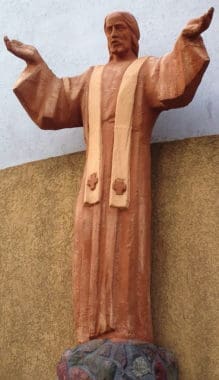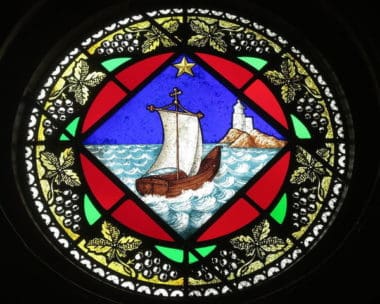The Need for a Liturgical Conscience
and Where to Get One
Part II of III
Editor’s Note: In Part I, Mr. Carstens introduced the concept of a liturgical conscience. In part II today, he will begin explicating the first five of the ten commandments of liturgical life.
10 Commandments of the Liturgical Life
Here are 10 principles to form the liturgical conscience. Perhaps there are more; maybe there are fewer. Undoubtedly they could be arranged or expressed differently—but knowing these will help us see the liturgy as the Church herself does.
1.The Liturgy Glorifies God and Sanctifies Humanity
The Constitution on the Sacred Liturgy describes the liturgy as a work “wherein God is perfectly glorified and men are sanctified” (n.7; also 10, 59, 61, 112). Here is the most basic, most fundamental, most essential liturgical norm. Is it also the most overlooked?
God’s glory and our salvation are “twin” goals since, as St. Irenaeus puts it, “the glory of God is man fully alive; moreover man’s life is the vision of God” (see Catechism of the Catholic Church, 294). To be a saint is the best way to glorify God; and to spend one’s life praising God is, as a consequence, to become a saint. These are the main purposes of the liturgy from its greatest source of power to its smallest detail: from the Eucharistic presence of Christ himself, to the cantor leading the congregation in song and prayer, to the doorknobs on the front entrance.
 2. The Liturgy is the Work of Jesus
2. The Liturgy is the Work of Jesus
Jesus Christ is the liturgy’s Prime Minister and, along with the Father and the Holy Spirit, its principal actor. “Christ is always present in his Church, especially in her liturgical celebrations. He is present in the sacrifice of the Mass, not only in the person of his minister, but especially under the Eucharistic species…, in the sacraments…, in His word…, and when the Church prays and sings…. Rightly, then, the liturgy is considered as an exercise of the priestly office of Jesus Christ” (The Constitution on the Sacred Liturgy n.7).
The liturgy is not about the priest, except insofar as he acts in the person of Christ the Head. It is not about the skill of the lector, except insofar as Jesus, the Word of God, is announced. It is not about me, except insofar as I am being transformed into Christ.
3. The Liturgy drives the Economy
“Economy,” in the truest sense of the word, means “the management of a household” (think of the home-economics class you may have had in high school, and you will get the idea). The work of Father, Son, and Spirit (see Commandment 2, above) is the management of a household—of creation, of the Chosen People, and now of the Church—back to the Trinity and eternal beatitude.

The liturgy, while contextualized within the Divine Economy, is also the powerhouse driving the propellers of the Ark of Peter back to the “Pearly Port.” God the Father, says the Constitution, “when the fullness of time had come sent his Son…anointed by the Holy Spirit…to be the mediator between God and men. Just as Christ was sent by the Father, so also he sent the apostles to accomplish the work of salvation which they had proclaimed by means of sacrifice and sacraments…” (nn.5-8).
Does the building committee, for example, know that it navigates the construction of a church (“nave” comes from the Latin, navis, or ship) for such a voyage?
4. The Liturgy Works in Sacramental Media
 St. Leo the Great left us a laconic liturgical maxim, “What was visible in our Savior has passed over into his sacraments.” The same Jesus who fed, healed, comforted, forgave, and died among the people of the Promised Land 2,000 years ago is the same Jesus who nourishes, cures, and forgives today—but through the medium of sacramental signs and symbols.
St. Leo the Great left us a laconic liturgical maxim, “What was visible in our Savior has passed over into his sacraments.” The same Jesus who fed, healed, comforted, forgave, and died among the people of the Promised Land 2,000 years ago is the same Jesus who nourishes, cures, and forgives today—but through the medium of sacramental signs and symbols.
“In the liturgy,” Sacrosanctum Concilium says, “the sanctification of the man is signified by signs perceptible to the senses, and is effected in a way which corresponds with each of these signs” (n.7). All that we see, smell, taste, touch, and hear in the liturgy brings with it, in a sacramental way, Jesus. Thus it matters what a minister does with his hands; there is significance in a new Paschal Candle and last year’s used one, or whether a bell calls worshippers to Mass. Far from simple reminders or pointers, these elements are bearers, porters, and potential epiphanies of what was once “visible in our Savior.”
5. The Liturgy Demands Active Participation
When it came to actually reforming and restoring the sacred liturgy, what was the most important principle for the Council Fathers? “In the restoration and promotion of the sacred liturgy, … full and active participation by all the people is the aim to be considered before all else” (Sacrosanctum Concilium, n.14).
But active participation does not mean, as Pope Benedict once put it, “something external, entailing a need for general activity, as if as many people as possible, as often as possible, should be visibly engaged in action” (The Spirit of the Liturgy, 171). On the contrary, “active participation” calls each of the baptized to actualize their baptismal priesthood by offering, with the priest, Jesus, the “unblemished sacrificial Victim,” but also “their very selves, and so day by day to be brought, through the mediation of Christ, into unity with God and with each other, so that God may at last be all in all” (General Instruction of the Roman Missal, 79).
Is this how you would describe your activity at Mass?
+
Editor’s Note: Part III will examine commandments six through ten of the commandments of the liturgical life.
+
Art for this post on The Need for a Liturgical Conscience: Modified detail of Kosciól Chrystusa Wieczystego Kaplana – Gniezno (The Church of Christ A Perpetual Priest – Gniezno [Poland]), MOs810, 25 November 2015 own work; Barque of Peter, Holy Trinity Catholic Church, Trinity, Indiana, Nheyob, 14 August 2016 own work; detail of Paschal Candle in Die Katholische Pfarrkirche St. Johannes Evangelist in Großhöbing bei Greding (The Catholic parish church of St. John the Evangelist in Grosshobing in Greding [Germany]), DALIBRI, 8 May 2016 own work; all CCA-SA 4.0 International; all Wikimedia Commons.





